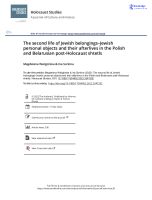The second life of Jewish belongings–Jewish personal objects and their afterlives in the Polish and Belarusian post-Holocaust shtetls
Author(s)
Publication Name
Publication Date
Abstract
This article examines the ways in which Jewish personal belongings that have been appropriated by gentiles during, and in the aftermath of, the Holocaust have been identified, demanded back, passed down from generation to generation, and commodified. Focusing on Biłgoraj and Izbica (Poland), and Mir and Iŭje (Belarus), our objective is to determine whether the Jewish identity of personal belongings appropriated by local non-Jewish communities during, or in the aftermath of, ‘Holocaust by bullets,’ survived in the postwar communities in which they have been circulating, and define what role they played for the postwar relations between Jews and non-Jews.
Topics
Artefacts and Material Culture Attitudes to Jews Holocaust Main Topic: Holocaust and Memorial Memory
Genre
Geographic Coverage
Copyright Info
This is an Open Access article distributed under the terms of the Creative Commons Attribution License (http://creativecommons.org/licenses/by/4.0/), which permits unrestricted use, distribution, and reproduction in any medium, provided the original work is properly cited.
Original Language
DOI
Link
Link to article including link to pdf, The second life of Jewish belongings–Jewish personal objects and their afterlives in the Polish and Belarusian post-Holocaust shtetls
Bibliographic Information
The second life of Jewish belongings–Jewish personal objects and their afterlives in the Polish and Belarusian post-Holocaust shtetls. 2022: https://archive.jpr.org.uk/10.1080/17504902.2022.2047292




